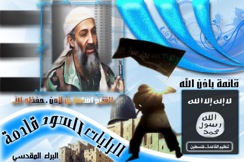
The image was produced by or for “al-Qa’ida-Palestine.” The banner is clearly designed as an aspirational or inspirational effort because no such group or media entity exists. Nonetheless the message of the designer (likely “al-Bara’ al-Maqdisi” whose name appears in the bottom left corner) is to assert Israel/Palestine as part and parcel of the global jihad movement. The appearance of Usama bin Ladin indicates to the viewer the group’s organizational affiliation and lends it an aura of legitimacy. The caption under the leader’s picture identifies him as al-Shaykh Usama bin Ladin and adds the common prayer for the living “hafizahu Allah” (“may Allah keep him [safe]”). On the bottom right appears a black banner logo bearing the shahada (Islamic testimony of faith holding that there is no god but Allah and that Muhammad is his messenger) and the group name “tanzim al- qa‘ida – filastin” (“al-Qa’ida-Palestine”). The caption at the bottom, sitting on top of the logo, reads: “qa’ima bi-idhni Allah” (“al-Qa’ida-Palestine stands/in existence, God permitting”).
According to prophetic tradition (hadith), the black flag was the battle flag of the Prophet Muhammad and it was carried into battle by many of his companions. The image of the black flag has been used as a symbol of religious revolt and engagement in battle (i.e., jihad). In the contemporary Islamist movement, the black flag with the shahada is used to evoke notions of jihad and of reestablishing the Islamic Caliphate. The caption at the bottom left reads: “al-rayat al-sud qadima” (“the black banners are coming”).
 Skip to content
Skip to content
